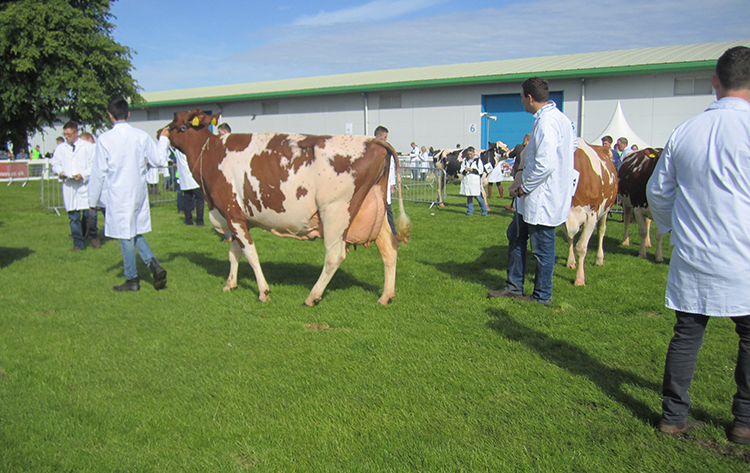
While different philosophies for breeding cattle cover the world, the same general idea of what is a desirable cow still holds true — the importance of quality udders and feet and legs that can endure many years, and the dairy strength to be able to produce large volumes of milk.
The top U.S. youth (4-H, FFA, and post-secondary) on the national level in the United States had the chance to test their skill at the Royal Highland Show in Edinburgh, Scotland at the end of June. They earned the privilege to compete in Europe by their top finish at last year’s national contests.
The judging contest is part of the “Scottish Dairy Stockman of the Year” competition for youth up to 25 years of age. The Scottish youth compete in additional venues, including a written exam on the Scottish dairy industry, showmanship, and cattle fitting. Great prestige comes with winning the title of Young Stockman of the Year. For the American students, they just compete in the judging portion and deliver two sets of oral reasons.
However, the method of how the classes are presented and the contest procedure offers some unique differences in this Scotland Contest.
All (Scottish and American) youth are divided in to four groups with a group leader to collect their placing cards. This contest included four classes — two Holstein cow classes and two Ayrshire cow classes. And the similarities pretty much stop there. Here are the 10 key differences I noticed between this Scottish contest and typical U.S. dairy judging contests.
- Students judge in white lab coats. It is similar to U.S. students who judge in the Meat Science evaluation contests.
- All cattle (16 head for the four classes) are in the large ring at the same time, each occupying one quadrant. Youth can stand in the middle of the four circling cows or on the outside of the cows to place them (like we typically do in North America). Some students even touch or feel the cows’ udders or ribs.
- Each class takes 5 minutes to judge — yes, even reasons classes. Cards are turned into the group leader after 5 minutes and then the students (not the cows) rotate to the next set group of four cows.
- The cows are numbered/lettered ABXY. Yes, A,B,X,Y, not A,B,C,D or 1,2,3,4 like most American students are used to. (I could not find the reason or source for this odd labeling.)
- There were only milking cow classes and no heifer classes were judged.
- After the students have rotated through the four classes, they proceed to a private area to work on their reasons. The entire judging portion is complete in less than 30 minutes.
- Oral reasons in Scotland are more about content and not as much in memorizing. Students were able to use notes without deduction.
- All cuts for all classes were 2-4-6 or a variation, such as 4-2-6 or 6-2-4. Higher deductions are for the most logical pair switch and the lower cut for the more challenging placing.
- There were no individual awards or top reason recognitions, just pairs (teams of two) were announced.
- First place is red and second is blue, similar to Canada and ties were not broken, but announced as ties.
Watch for future blogs in this series on the 2019 International Dairy Tour. The upcoming one will share the results of the Royal Highland Show contest and comments from the top teams.

The author is the online media manager and is responsible for the website, webinars, and social media. A graduate of Modesto Junior College and Fresno State, she was raised on a California dairy and frequently blogs on youth programs and consumer issues.








